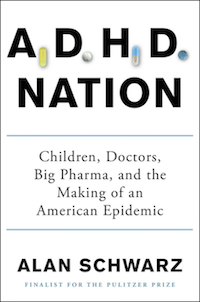ADHD
How We Became ADHD Nation
Alan Schwarz’s bracing book on the making of a distinctly American epidemic
Posted September 30, 2016

“ADD could replace oedipal anxiety as a new universal explanation; I urge restraint.” So warned Dr. Judith Rapoport of the NIMH to colleagues working on the 1980 Diagnostic and Statistical Manual of Mental Disorders about glaring overlaps among the proposed criteria for Attention Deficit Disorder. “Easily distracted” appeared right next to “has difficulty concentrating.” The obvious redundancy risked loosening an already vague definition, making diagnosis even easier. Not requiring signs of “hyperactivity” also meant girls would henceforth be diagnosed in much higher numbers.
In the end, as Alan Schwarz recounts compellingly in ADHD Nation: Children, Doctors, Big Pharma, and the Making of an American Epidemic (Scribner), the restraint that Rapoport counseled was ignored. Children who “fail to finish things” came to be listed in ADD’s formal symptoms alongside children who have “difficulty sticking” to tasks, and so on, in turn fulfilling still a third vague criterion—“shifts excessively from one activity to another.” Rapoport had been streamrolled. The loose, overlapping list of symptoms went to press and the rest is history: a distinctly American epidemic supported by the massive overprescribing of Ritalin, followed by Adderall, as well as multimillion-dollar marketing campaigns for each. By 2013, Schwarz reports, “ADHD diagnoses reached a staggering 15 percent of children nationwide, and 20 percent of boys."
The story of how more than one in seven American children and teens came to be diagnosed with ADHD is told with impressive detail and reporting. Schwarz, a Pulitzer Prize-nominated investigative reporter for the New York Times, draws on multiple sources, among them unpublished documents and interviews with “more than a thousand people, primarily doctors, parents, students, researchers, government officials, and other experts in ADHD.”
We learn how the disorder’s most ardent defender, Dr. C. Keith Conners at Duke University, now views its widespread diagnosis as “a national disaster of dangerous proportions.” How methylphenidate (brand name Ritalin) came to exist as but a “slightly tweaked formulation” of the highly addictive amphetamine Dexedrine, itself massively overprescribed in the 1960s and '70s, with symptoms in children not dissimilar from its parent form as speed. And how Adderall got its name from the very disorder its manufacturers hoped would become inseparable from it as a treatment:
All.
For ADD.
ADD for All.
Adderall.
Just as incredible, Schwarz reproduces the commercially marketed “Conners Rating Scales” that the Duke professor agreed to sell in 1989. Thereafter, it was hauled in vast quantities to doctors’ offices nationwide and somehow became the industry standard for psychiatric diagnosis, though its formal criteria for telltale behaviors continued to list “pouts and sulks,” “daydreams,” “acts ‘smart’ (impudent or sassy),” and “restless in the ‘squirmy’ sense”—in short, a basic definition of childhood.
ADHD Nation points repeatedly to a dilemma among psychiatrists over how to name and properly identify the behavior they hoped to diagnose. First defined as “Hyperkinetic Impulse Disorder” in the 1950s, the disorder was subsequently renamed “Minimal Brain Dysfunction.” (“Hyperkinesis” appeared too restrictive and “Attentional Deviation Syndrome,” another name floated, didn’t catch the desired focus on hyperactivity.) Yet as Schwarz archly notes, “‘Minimal’ [also] didn’t exactly convey anything worthy of respect or governmental funding”—its very name limited the pool of potential patients and lacked the diagnostic ambition of psychiatrists wanting terminology with widespread applicability.

The 1980 DSM went with “Attention Deficit Disorder,” which freed the term from its previously “ugly minimal brain dysfunction moniker,” but bore such resemblance to ordinary behavioral difficulties that the number of diagnoses increased rapidly, “with hundreds of thousands of new children identified each year.”
The sharp rise in Ritalin prescriptions follows an almost exact parallel, “doubling every six years since the early 1970s” and in the late 1990s increasing “a stupefying 400 percent in just five years,” with just a brief falling-off period between 1987 and 1990. That was due to several well-publicized lawsuits and media coverage warning of lax prescribing. “From just 1990 to 1993,” Schwarz continues, “annual diagnoses more than doubled from 900,000 to two million. They kept rising from there.”
Supporting the massive increase in prescribing were all the usual suspects: Pharma-sponsored patient support groups such as CHADD (Children and Adults with Attention Deficit/Hyperactivity Disorder), which had accepted almost $1 million since 1989 in undisclosed funding “to attract parents and fuel its growth.” Key opinion leaders (KOLs) in psychiatry, mostly well-meaning but also massively ambitious for the disorder they had studied and redefined, who were willing to expand its diagnostic range at the drop of a hat. Psychiatrists and general practitioners only too glad to write a prescription for the crowds now swelling their previously empty waiting rooms. An enabling, often uncritical media, which at first represented the medications prescribed as wonder drugs with few side effects. And harried, often highly competitive parents willing to fill any prescription if it meant their child would maintain their GPA. Added to this, particularly in the case of Adderall, Schwarz notes: the many thousands of students at college and, increasingly, high school, who would become willing to fake symptoms of ADHD—hardly difficult, given their widespread applicability—to take prescription stimulants as study aids, with a well-documented spike in visits to the emergency room as a result. After all, “the drugs were still amphetamines. Eventually, that fact became all too clear.”
As one would expect of a seasoned reporter at the New York Times, Schwarz tells this complex story with flair and an eye for detail. The expansion here of articles previously published in the Times gives him the scope to bring in accounts of parents and students caught up in the drama of diagnosis, treatment, and recurring side effects. Yet it is in one sense the very precision of Schwarz’s account of the repeated renaming of ADHD, with its altered and greatly expanded list of everyday symptoms, that cuts against the opening to his book: “Attention deficit hyperactivity disorder is real. Don’t let anyone tell you otherwise.”
The somewhat perplexing issue here is that it is in fact Schwarz himself who rightly and repeatedly “tells us otherwise.” He doesn’t question, as some have, that ADHD is a medical phenomenon. But his precise rendering of the behavior’s vague definitions and complex history makes it almost impossible to reconcile “Minimal Brain Dysfunction” with the 1980 and later versions of “Attention Deficit Disorder,” since they define the problem in such different ways. For one thing, the latter term came to define a "lifelong condition"—something not even implied in the earlier literature.

That elasticity or diagnostic imprecision is clearly part of the story in the making of this American epidemic. Some might even view it as the story’s enabling condition. To minimize that from the start of the book is to suggest in part that there’s a bedrock to the diagnosis that we can separate from the pharma-sponsored hype, the funded patient groups, the selectively reported trials, and the KOLs who find personal checks left on their desks (“for further studies”) and scripts handed them if they’ll outright deny the medication’s side effects (“We’ll give you a thousand dollars if you say this for a half-hour”).
Part of the strength and accomplishment of ADHD Nation is that such separation is shown to be impossible. If the DSM and psychiatric establishment still referred to a phenomenon known half a century ago as “Minimal Brain Dysfunction,” Schwarz implies, the ADHD epidemic we are now enduring could never have happened.
The issue goes far beyond semantics. As Schwarz rightly observes of the consequences of such emphases, “Whether it’s just one child or today’s six million, if we’re going to tell a kid that he has a permanent, potentially devastating brain disorder, we’d better damn well be right.”
christopherlane.org Follow me on Twitter @christophlane




